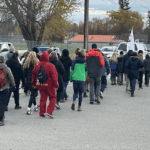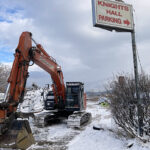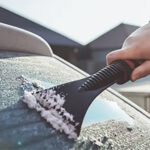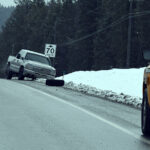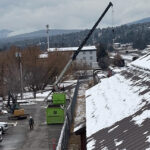Home »
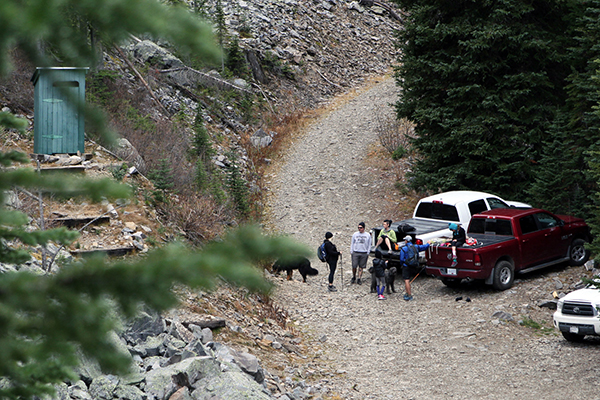
Backroads safety key to reaching spectacular heights
By Julie Brannigan
It isn’t the hike up Lakit Lookout that’s a challenge. It’s the drive.
My husband and I led a group of ‘first-timer’ friends up the mountain recently and the drive to the trailhead proved more gruelling than the hike.
I was worried about my nine year-old who loudly expressed her displeasure on one of last year’s adventures, but her protests were so mild they barely registered. It was the grown sisters in the other truck making all the noise.
“The older one makes no bones about it when she’s nervous,” says their Dad. “And that makes the younger one more anxious, and angry with her sister for making her that way.” Both girls grew up in the city and their idea of a backroad is more pastoral than the rutted, narrow, blind-cornered reality of Lakit.
I poke fun at these young ladies, (who I dare not name), but I’m not fond of that road either. I can travel it with less drama only because I have more experience and more confidence in my driver.
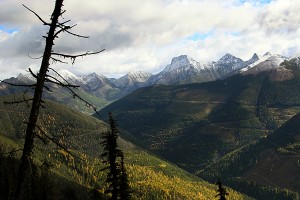 My husband grew up in the Territories where there was nothing but gravel roads, and he honed his driving skills on the RCMP track. We’ve also learned a few things the hard way.
My husband grew up in the Territories where there was nothing but gravel roads, and he honed his driving skills on the RCMP track. We’ve also learned a few things the hard way.
The following list is a good starting point for anyone considering a drive into the middle of nowhere:
1. Make sure your tires can handle it. On our way back from Blue Lake Camp this summer we discovered – by means of a spectacular flat – that our brand new truck had four ply ‘city’ tires on it. Not much good on a Kootenay four-by-four! If you plan on doing a lot of backcountry travel, invest in a set of 10 ply, e-load tires.
2. Even if you have appropriate tires, don’t venture forth unless you know how to change a tire and have the right tools for the job. (If there are little kids around, I hope your skills are up to snuff. They like nothing to better than to stand around and listen to you curse!)
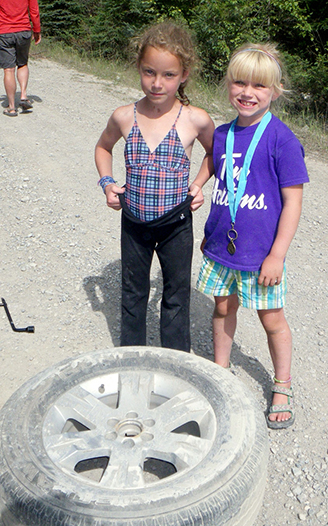 3. Pack a saw. A log blocking the road on the way in can keep you from your destination. If a storm blows in while you’re on the trail, it could stand between you and home.
3. Pack a saw. A log blocking the road on the way in can keep you from your destination. If a storm blows in while you’re on the trail, it could stand between you and home.
4. Use your gears. If you have 4 x 4, engage it. On the way down the mountain use your gears, not your brakes, to control your descent.
5. Save the beer for home.
6. Make sure your gas tank is full.
7. Make sure your vehicle is in good repair. Most of our roads go further than your cell phone coverage. If you break down your Roadside Assistance plan consists of the first stranger who drives by.
8. Take it easy out there. It takes longer to stop on gravel than it does on pavement, and just because It feels like you’re alone out there, it doesn’t mean you are.
9. Go in a group. If one vehicle breaks down, you’ve always got another way home. (Trust me, I’ve been there and done that).
10. Always have basic safety supplies in your vehicle: water, matches and a blanket or two.
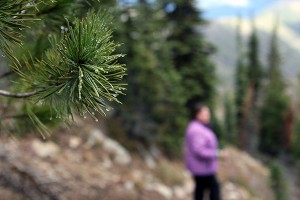 I hope this doesn’t sound too scary! Standing on top of a mountain (even a small one like Lakit) and identifying your town, your rivers and your favourite hoodoos in the distance is a bucket list experience.
I hope this doesn’t sound too scary! Standing on top of a mountain (even a small one like Lakit) and identifying your town, your rivers and your favourite hoodoos in the distance is a bucket list experience.
The white knuckles are quickly forgotten when beams of light isolate orange stands of larch on the other side of the valley, or when you spot a mid-summer butterfly up higher than you ever expected.
Take in a deep breath of fresh mountain air and go for it!
 – Julie Brannigan is a working mother of two who has lived at River’s Crossing since 2012 in a home designed to include a sun-filled suite for her parents. With nature out the door and ‘Granny Nanny’ and Grandpa across the hall from Julie and her husband Tom, she says she can’t ask for more.
– Julie Brannigan is a working mother of two who has lived at River’s Crossing since 2012 in a home designed to include a sun-filled suite for her parents. With nature out the door and ‘Granny Nanny’ and Grandpa across the hall from Julie and her husband Tom, she says she can’t ask for more.

